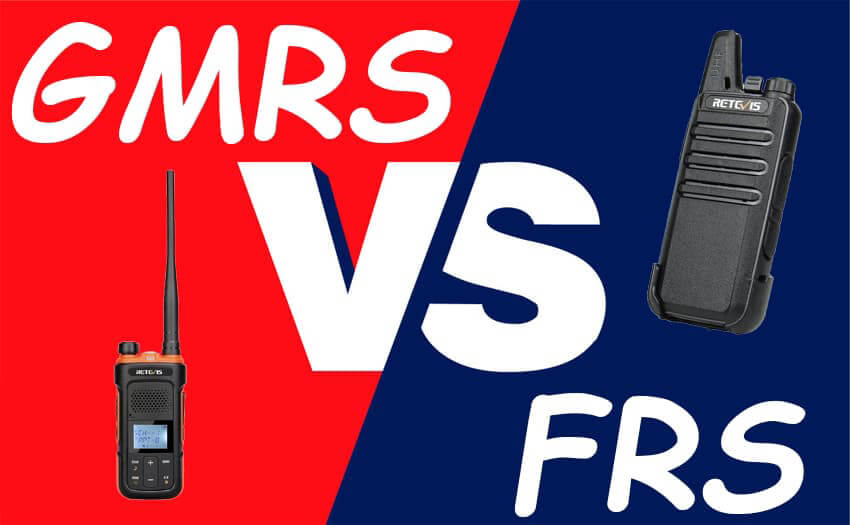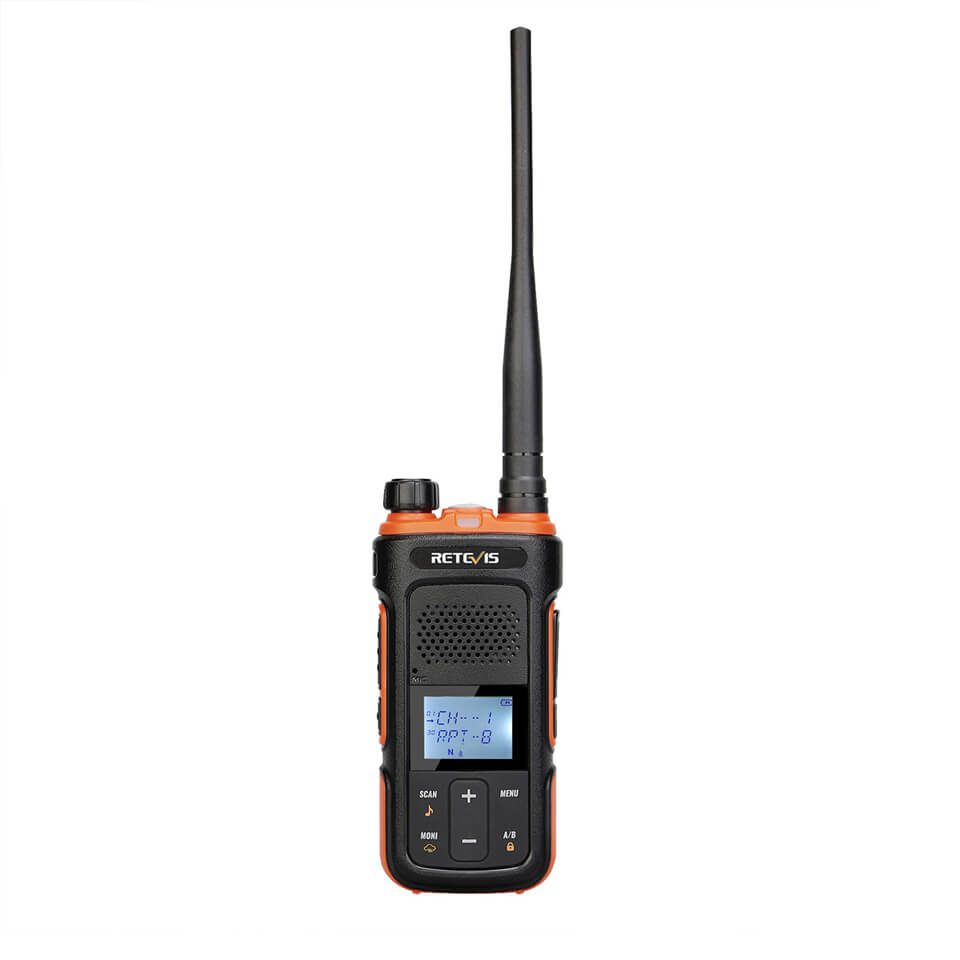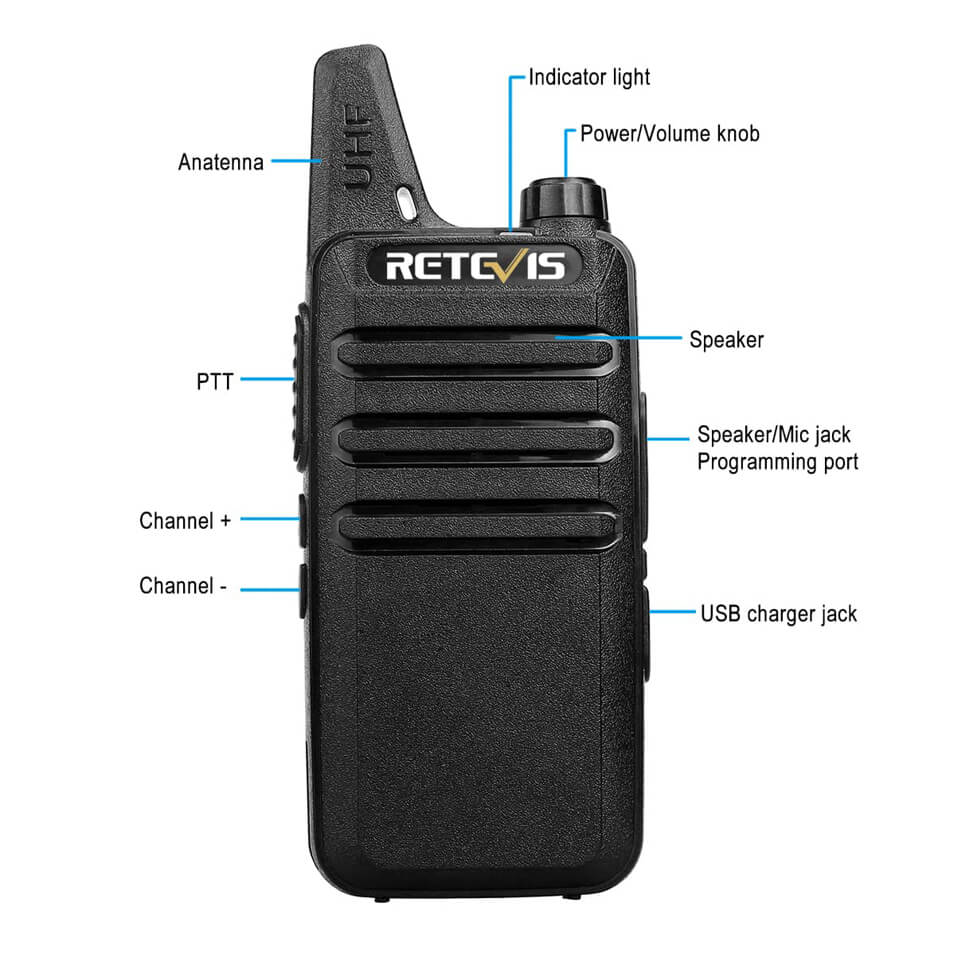What is the difference between GMRS and FRS ?
- Retevis Solutions
- GMRS radio, FRS Radio, license free walkie talkie, General Mobile Radio Service, Family Radio Service

The General Mobile Radio Service (GMRS) is a licensed radio service that uses channels around 462 MHz and 467 MHz. The Family Radio Service (FRS) is an improved walkie-talkie radio system authorized in the United States since 1996. This personal radio service uses channelized frequencies around 462 and 467 MHz in the ultra-high frequency (UHF) band. Judging from the definition of GMRS and FRS, they seem to have no difference in the frequency range, so What is the difference between GMRS and FRS?

First, GMRS and FRS Frequency difference.
GMRS radio uses specific frequencies designated for FRS radio in the same frequency band: 462-467 MHz. The difference is that GMRS radios specify channels that cannot be used for FRS radio in those frequencies. All 22 Channels are shared with the General Mobile Radio Service (GMRS).
Second, GMRS and FRS power difference.
In FCC regulations, FRS radios are limited to 2 Watts on channel 1-7 and channels 15–22, while GMRS operators are permitted to transmit at up to 50 watts, on the 16 main channels, but transmitting 1W to 5W is more common in practice. For GMRS handheld radio, it is also not over 5W.
Third, License requirement difference.
FRS is licensed by rule. This means an individual license is not required to operate an FRS radio provided you comply with the rules. You may operate an FRS radio regardless of your age, and for personal or for business use if you are not a representative of a foreign government. An FCC license is required to operate GMRS system. Licenses are issued for a ten-year term and can be renewed between 90 days prior to the expiration date and up to the actual expiration date of the license. After a license expires, an individual must request a new GMRS license.
You may apply for a GMRS license if you are 18 years or older and not a representative of a foreign government. If you receive a license, any family member, regardless of age, can operate GMRS stations and units within the licensed system(The FCC service rules for the GMRS are located in 47 C.F.R. Part 95 Subpart E. You can find information about GMRS licensing in the rules).

Fourth, Bandwidth and channel spacing difference.
The FCC stipulates a specific channel bandwidth for FRS and GMRS. The bandwidth is constrained by the modulation which is FM deviation (GMRS = +/- 5.0 kHz, FRS = +/- 2.5 kHz) plus the uncertainties of the filtering of the transmitter and receiver. Additionally, receivers and transmitters may drift over time or temperature so the bandwidth is further constrained to prevent interference to the adjacent channel. Channel spacing is 25 kHz for GMRS and so a 20 kHz bandwidth fits into that channel with protection on each side. FRS channels are spaced within a 12.5 kHz space directly between two GMRS channels. FRS radios generally utilize an 11 kHz transmitter bandwidth and a lower power than GMRS so the interference to an adjacent GMRS channel is minimized.
Fifth, Talking range difference.
Theoretically, the range between two FRS hand-held units would be about 1.5-2.5KM; the range between two GMRS hand-held units would be about 2.5-3.5KM, mobile units have higher antennas and a range of around 5 miles (8 km). A GMRS repeater with an antenna that is high above the surrounding terrain can extend the usable range over a wide area – for example, up to a 20–mile (32.2 km) radius around the repeater station. While FRS radio not allowed for higher antennas and repeaters. Obstructions such as hills and buildings can reduce range. Higher power does not necessarily give a proportional increase in range, although it may improve the reliability of communication at the limits of line-of-sight distance. Compared with FRS, GMRS has a longer communication distance and can be called a legitimate long-distance walkie-talkie.
Frequency Table of FRS and GMRS:
| Frequency | FRS | FRS Power | FRS | GMRS Power | GMRS |
| Channel | Bandwidth | Bandwidth | |||
| 462.5625 MHz | 1 | 2 W | 12.5 kHz | 5 W | 20 kHz |
| 462.5875 MHz | 2 | 2 W | 12.5 kHz | 5 W | 20 kHz |
| 462.6125 MHz | 3 | 2 W | 12.5 kHz | 5 W | 20 kHz |
| 462.6375 MHz | 4 | 2 W | 12.5 kHz | 5 W | 20 kHz |
| 462.6625 MHz | 5 | 2 W | 12.5 kHz | 5 W | 20 kHz |
| 462.6875 MHz | 6 | 2 W | 12.5 kHz | 5 W | 20 kHz |
| 462.7125 MHz | 7 | 2 W | 12.5 kHz | 5 W | 20 kHz |
| 467.5625 MHz | 8 | 0.5 W | 12.5 kHz | 0.5 W | 12.5 kHz |
| 467.5875 MHz | 9 | 0.5 W | 12.5 kHz | 0.5 W | 12.5 kHz |
| 467.6125 MHz | 10 | 0.5 W | 12.5 kHz | 0.5 W | 12.5 kHz |
| 467.6375 MHz | 11 | 0.5 W | 12.5 kHz | 0.5 W | 12.5 kHz |
| 467.6625 MHz | 12 | 0.5 W | 12.5 kHz | 0.5 W | 12.5 kHz |
| 467.6875 MHz | 13 | 0.5 W | 12.5 kHz | 0.5 W | 12.5 kHz |
| 467.7125 MHz | 14 | 0.5 W | 12.5 kHz | 0.5 W | 12.5 kHz |
| 462.5500 MHz | 15 | 2 W | 12.5 kHz | 50 W | 20 kHz |
| 462.5750 MHz | 16 | 2 W | 12.5 kHz | 50 W | 20 kHz |
| 462.6000 MHz | 17 | 2 W | 12.5 kHz | 50 W | 20 kHz |
| 462.6250 MHz | 18 | 2 W | 12.5 kHz | 50 W | 20 kHz |
| 462.6500 MHz | 19 | 2 W | 12.5 kHz | 50 W | 20 kHz |
| 462.6750 MHz | 20 | 2 W | 12.5 kHz | 50 W | 20 kHz |
| 462.7000 MHz | 21 | 2 W | 12.5 kHz | 50 W | 20 kHz |
| 462.7250 MHz | 22 | 2 W | 12.5 kHz | 50 W | 20 kHz |
| 467.5500 MHz | N/A | N/A | N/A | 50 W | 20 kHz |
| 467.5750 MHz | N/A | N/A | N/A | 50 W | 20 kHz |
| 467.6000 MHz | N/A | N/A | N/A | 50 W | 20 kHz |
| 467.6250 MHz | N/A | N/A | N/A | 50 W | 20 kHz |
| 467.6500 MHz | N/A | N/A | N/A | 50 W | 20 kHz |
| 467.6750 MHz | N/A | N/A | N/A | 50 W | 20 kHz |
| 467.7000 MHz | N/A | N/A | N/A | 50 W | 20 kHz |
| 467.7250 MHz | N/A | N/A | N/A | 50 W | 20 kHz |
Whether to choose FRS or GMRS walkie-talkie, you must first understand the difference between them before buying. This article can help you better understand FRS and GMRS.
We Retevis Solutions focus on long range walkie talkie and radio solutions. For more radio solution help, welcome to contact Retevis Solutions: info@retevis.com.






